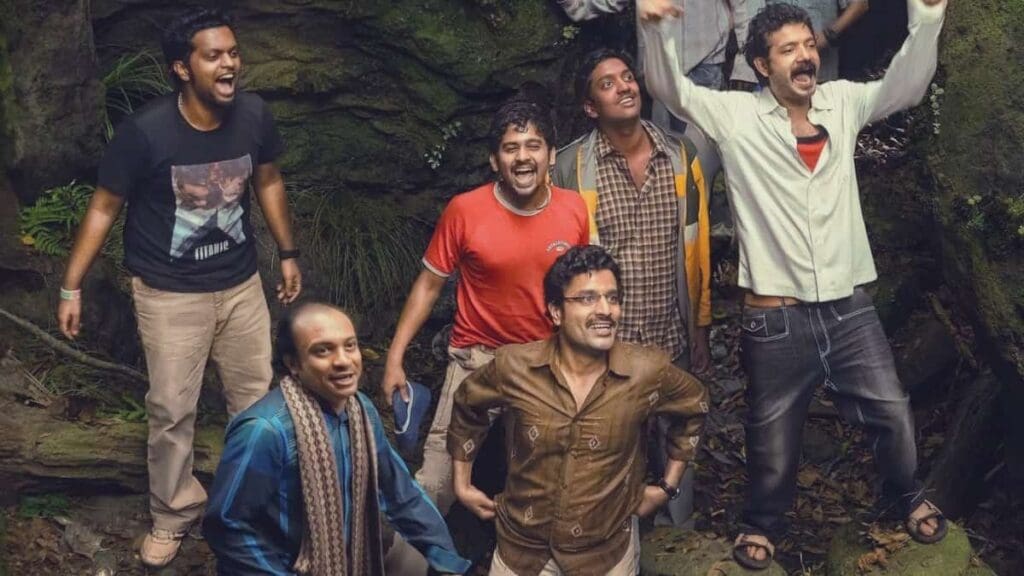
As David Emile Durkheim conceived the fundamental fact in his socio-spatial theory, no society ever exists without the spatial context. Yet, Social space is not merely a reflection of social life, but a crucial constituent of it. Chidambaram’s recent Malayalam movie Manjummel Boys invigorate us to redefine this aspect. Numerous reviews have surfaced recently, lauding the unconventional craftsmanship of Chidambaram. However, this writing aims to scrutinize the socio-spatial aspect of Majnummel boys to gain deeper insights.
The film Manjummel Boys is an experiment to illustrate a particular incident from the life of a group of eleven boys (ten boys and the driver) who belong to Manjummel, a town on the bank of the river Periyar. This group of individuals appears to be unacquainted with mainstream cinema, however, the film Kammattippadam (2016) was a trial to cater to such a particular community. There are plenty of others, yet, most of them seem to lack an accurate depiction of the radicle belongs. These individuals are not worthy of any aspect of ‘value.’ propriety might be an unheard word for them, or who else will be ready for a tug of war in the house of marriage? The placement of the initial song (own produced) titled ‘Kuthanthram‘ is noteworthy as it effectively establishes the foundation and environment in which the characters exist. The famous lyrics of Poykayil Appachan, ‘I couldn’t find anything from the history, on my community,’ are reminiscent of the line from the song (Kuthanthram), ‘The one with hardly an identity.’ The individuals are heavily influenced by the presence of the Periyar and industrial factories, both in a symbolic and literal sense, leading (or living) a life of smoke. Here, the question arises: Does language mould your space, or does space mould your language? The boys’ vernacular aligns with their surroundings. For example, Subash (played by Sreenath Bhasi) says “What a dead smell” upon entering Guna cave, which could refer to the scent or atmosphere of death, or even read as Subash knows what the smell of death is like. To a proletarian social background, an annual trip to Kodai is a luxury that requires months of planning and savings. Yet, the car they are riding in is a Qualis for eleven people, and reducing the count is not because it is futile, but because they have to face legal consequences. Saying that these boys share the same character would be an overinterpretation. Eleven individuals come together for a specific purpose in a momentous time in cinema, demonstrating the social/organic solidarity of Durkheim. According to him, society becomes more capable of collective movement, at the same time that each of its elements has more freedom of movement. Despite the perilous situation, the group managed to survive the incident collectively, although the circumstances became increasingly challenging. In the realm of narrative composition, typically, the dynamic between the protagonist and antagonist engrosses the audience. In this scenario, destiny assumes the role of the antagonist, and our abilities to mitigate its influence are limited.
Retro songs are popular nowadays, but few do justice to the originals. The song ‘Kanmani anbodu‘ from Guna (1991) is a prominent character throughout the cinema. Sushin Shyam, the music director, played a vital role by seamlessly merging the music with the visuals. The film has every flavour to idolize the characters, but the director, Chidambaram, has taken a philosophical approach. In a casual scene, Subash, an atheist, initiates a conversation with Prasad (Khalid Rahman) and inquire about the true nature of God. Prasad replies that God might be a form of light emanating from the atmosphere, and Subash sarcastically replying it was night and dark then. While Subhash is unconscious in the pit, he dreams of walking naked through the cave. He notices an end and a light from above, where Subash sees himself. The red-coloured cave implies a womb and Subash being reborn. The audience anticipates Subash to acknowledge Kuttan (Played by Soubin Shahir) and the boys, but he doesn’t. Instead, Chidambaram portrays Kuttan as rescuing one of the boys in their childhood, serving as a testament to the strength of their informal kinship. To Subash’s mother, Kuttan is a god, while to the locals, Subash is a deity who survived death.
The juxtaposition of Subash’s past of single parenting with the backdrop of a darkened painted house, and the subsequent relief provided by his friendship against lush greenery (yet the industrial smoke in the background) land and warm water was a masterful example of visual storytelling. The recurring view of the three Kodai mountains instilled a sense of apprehension, as it served as a stark reminder of the distressing circumstances that occurred. The replication of the scenes of lying down with the mother was precise to establish a strong emotional resonance with the target audience. The notable aspect of Manjummel Boys is that each character is thoughtfully crafted with depth and nuance, resulting in a well-rounded and engaging cast. Undoubtedly, Manjummel Boys will be known for its exemplary making as film in the future.
‘Up to what extent are you willing to go for your friend.?’
Akhila is a graduate of Delhi University.



